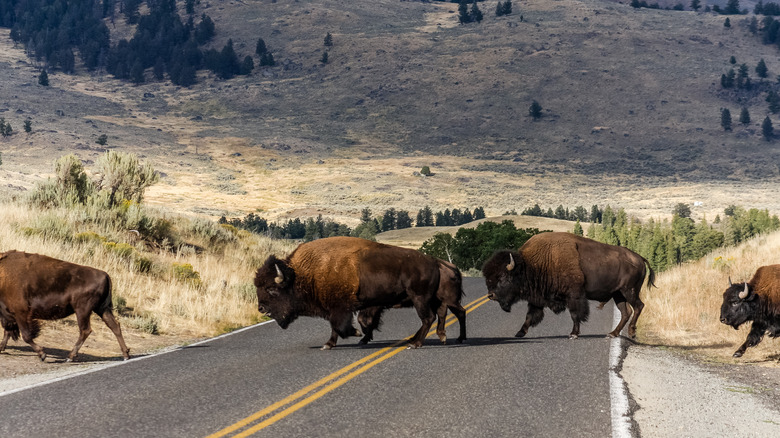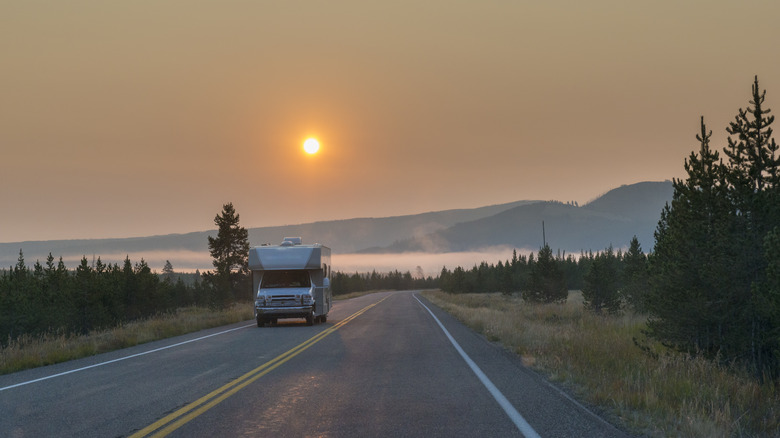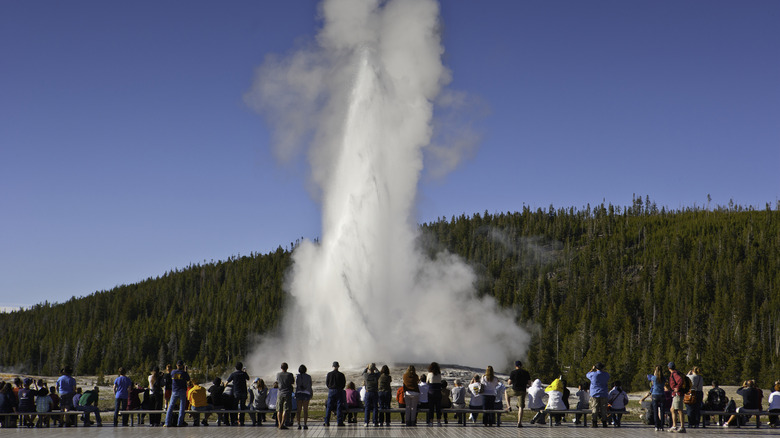The Most Dangerous Activity To Do In Yellowstone Isn't What You Think
Yellowstone was America's first official national park, and today, over 150 years after it was founded, Yellowstone remains an icon of the country's epic natural beauty. The Greater Yellowstone Ecosystem is one of the world's most unique and complex eco-regions, with abundant displays of mountains, forests, water systems, and animal life found in few other places on Earth. Thanks to its intricate natural splendor, Yellowstone is regularly atop many camping bucket lists. The park's geothermal features also create some of the most iconic wonders in the entire National Park System. The consistent spectacle of the Old Faithful geyser and the multicolored, otherworldly scene of Grand Prismatic Spring are among Yellowstone's top tourist attractions. Add the magnificent grandeur of the Grand Canyon of the Yellowstone River and Yellowstone Falls, and it's easy to see why it is one of the most-visited American national parks.
But no park can retain such rugged natural features without posing a few dangers as well, and Yellowstone is no exception. The park is home to several potentially dangerous animals, including bears, wolves, and bison. Yellowstone's hot springs and hydrothermal features can cause severe (and potentially fatal) burns to anyone who ignores safety warnings and gets too close. And then there's the whole business of the park sitting atop a "supervolcano" that could erupt and kill millions of people. However, while its natural features can be deadly, Yellowstone's biggest danger is a bit boring by comparison. For all the risks of wildlife, geology, and the park's mountainous landscape, statistics reveal that driving is actually the most dangerous activity in Yellowstone National Park.
For all its supervolcanoes, geysers, and dangerous wildlife, Yellowstone's most dangeorus activity is actually driving
According to statistics, 74 Yellowstone visitors have tragically lost their lives between 2007 and 2023. Of those 74 cases, the single most common cause of death is a generic "medical" emergency, responsible for 18 deaths within that timeframe. However, medical emergencies can strike anytime, anywhere, so this does not necessarily point to any single activity being particularly dangerous. But close in second place is "motor vehicle accidents," which were officially responsible for 17 of the park's 74 fatalities. If you rank deaths by activity, the trend becomes much clearer. While outdoor activities like hiking, swimming, and climbing are responsible for several deaths in Yellowstone, the park's single most dangerous activity is driving.
This does make some sense, of course. Throughout the country, motor vehicle accidents are the second most common cause of death for "unintentional injuries," with several thousand people each year losing their lives while driving. Though Yellowstone is famous for its pristine and wild character, its size and booming tourism stats mean that most people will still get around via car.
Most of the park's roads have a speed limit of 45 mph, but speeding remains a major safety hazard. More popular areas of the park can see sudden traffic jams, which can become particularly dangerous when combined with speeding drivers. The park's roads rarely have shoulders, making it hard to pull over in an emergency. Wildlife can also cross the road without warning and can cause speeding drivers to swerve suddenly and lose control. When winter hits, icy conditions can make the roads even more dangerous. Since winter is arguably the best time to visit Yellowstone, drivers should be prepared to deal with winter conditions.
Despite the dangers, you can still have a fun (and safe) trip to Yellowstone with some basic common sense
The good news is that you can undoubtedly have an accident-free trip to Yellowstone simply by exercising some basic sense, both on the road and elsewhere. Following the park's posted speed limits, keeping your eyes on the road, and not attempting to pass cars in front of you can go a long way in reducing the risk of traffic accidents. In other words, simply follow the same safe driving principles as you would outside the park.
Likewise, this "basic sense" principle applies to areas that are more specific to Yellowstone. The park's amazing wildlife is among its top features. But these animals are actually wild, not tourist attractions there for your amusement. To avoid tragic encounters between human visitors and animal residents, always keep your distance from any animals you see in the park. The general rule of thumb is to stay at least 25 yards from large herbivores like bison and elk, and at least 100 yards from carnivores like bears and wolves. It's also extremely important to never feed any animal in the park, no matter the species.
Yellowstone's geothermal features have designated boardwalks, railings, and fences designed to keep all visitors at a safe distance from dangerous temperatures or steam. Deaths and injuries from geothermal features most likely occur when someone disregards safety warnings and bypasses designated pedestrian areas. All of these precautions boil down to "follow posted safety guidelines and use common sense." If you do this, and maybe avoid Yellowstone's infamous "Zone of Death" in its small Idaho section, you can have a fun, memorable, and, most importantly, safe visit to the park.


